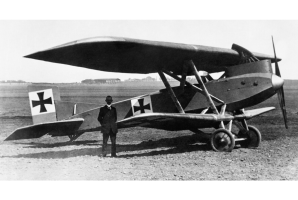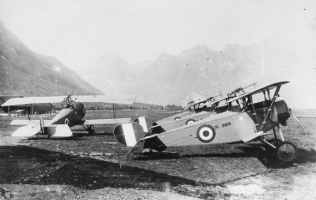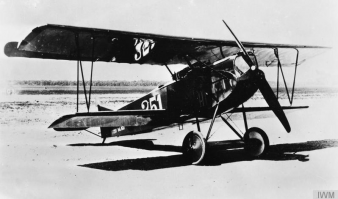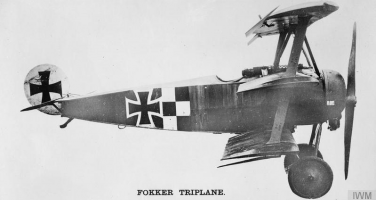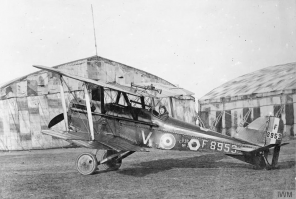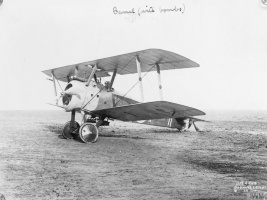Introduction↑
Aircraft and aircraft technology changed rapidly from 1914 to 1918. Not long after the Wright Brothers’ first flight on 17 December 1903, the major European powers began to recognize the military implications of heavier-than-air machines. In the decade since the Wright flyer, aircraft had developed standard components that generally exist to this day. Internal combustion gasoline engines provided propeller-driven propulsion, wings produced lift, and flight controls – ailerons, elevators, and rudders – permitted control. There were wide variations in configuration and engineering details, especially in the early years, but, in general, the trend was towards faster, higher flying, stronger, and more capable airplanes. Armament, by 1915 in the form of the machine gun, was increasingly important as well.
Technological Improvement↑
At the beginning of the war, many of the aircraft were characterized by open wooden-framed fuselages and pusher-type engines. Biplane wings had wooden main spars and ribs, were fabric-covered, externally braced by wire, and doped. Engine horsepower varied between seventy and 110. Despite their flimsy appearance and visible bracing, most were relatively robust and considered easy to fly. Nevertheless, engines needed constant attention and overall performance was limited.
Designers and engineers in all nations were quick to make improvements. With individual exceptions, most settled on the biplane as the best compromise between speed and maneuverability. Fuselages – featuring framed wood, plywood construction, or metal tubing – were streamlined and covered with fabric. Engine location generally favored the nose of the aircraft, particularly after Anthony Fokker’s (1890-1939) introduction of interrupter gearing that allowed pilots to aim and shoot at an enemy aircraft through the propeller arc. Instrumentation was rudimentary in the extreme and, early on, generally only featured the minimum necessary to monitor the engine.
Notable World War I Aircraft↑
A number of World War I aircraft stand out as notable, perhaps less so for their overall performance, but rather for their impact on future development. Fokker’s E type monoplanes, I-III, were rotary-engined and mounted a single synchronized machine gun. These aircraft, flown by aces like Max Immelmann (1890-1916) and Oswald Boelcke (1891-1916), were responsible for the so-called “Fokker scourge” during the winter of 1915-1916. The French Nieuport series of fighters – 11, 16, 17, 24, 27 and 28 – took advantage of the French superiority in engine development and production and were built in substantial numbers. Rotary engines, while generally reliable, had horsepower limitations and increased aerodynamic drag.
Developments and improvements in technology inevitably led to changes in employment techniques and principles. Early in the war, fighter aircraft were often employed singly in “lone wolf” missions. Shortly thereafter, however, effectiveness and deadliness were improved by flying in pairs. Formation flying with multiple aircraft followed, as the notions of mutual observation, firepower, and support grew. Oswald Boelke took the lead in understanding the relationship between aircraft technology and tactical employment. His famous “Dicta,” which might be considered the first clear summary of the rules of air combat, successfully changed the air battlefield and the nature of air warfare. His fundamentals remain a central part of airpower and fighter doctrine even today.
Technological improvements changed alongside doctrine. One of the most successful German designs, the Albatross, capitalized on German automotive advances by using liquid-cooled in-line Mercedes engines. This allowed the fuselage of the aircraft to be further streamlined with a corresponding increase in overall top speed. Ranging across five models, D.I – D.Va, these fighter aircraft proved superior to many Allied types for several months in 1917 and were responsible for thousands of British and French casualties.
The S.E. 5 was the British response to the Albatross D.III. It was introduced in April 1917, and eventually more than 5,200 were built. Flown by famous aces like Albert Ball (1896-1917), Mick Mannock (1887-1918), and James McCudden (1895-1918), it was a formidable fighter aircraft, powered by a 200 h.p. Hispano-Suiza engine. Despite its favorable maneuverability, in many ways, the S.E.5 reflected a general trend in fighter aviation towards overall utility and strength at the expense of pure dogfighting ability.
An exception to this rule might be the Fokker Dr.I, made famous by World War I’s ace-of aces, Manfred von Richthofen (1892-1918). Copying a previous British Sopwith design, Fokker produced very limited numbers of a triplane powered by a rotary engine. Slower and more fragile than its contemporaries, the Dr.I nevertheless exhibited amazing aerobatic capabilities, and, in the hands of experts like Richthofen and Werner Voss (1897-1917), brought lasting fame to the design.
Britain produced an aircraft every bit the equal of the Dr.I in combat, however. The Sopwith Camel F.1 arguably represents the near culminating point of British design. A rotary-engined biplane with two synchronized machine guns, it was relatively fast, maneuverable, and had a service ceiling of nearly 20,000 feet. Almost 5,500 were built by the war’s end.
France’s Nieuports gave way in performance to SPADs, especially the SPAD XIII, a dominant French fighter that has the distinction of being produced in larger numbers than any other aircraft of the war. Powered by a 235 h.p. engine, it was capable of a remarkable top speed of nearly 140 m.p.h.
According to some historians, the apex of World War I fighter design was reached by the Germans with the Fokker D.VII. It featured ease of control, excellent all-around performance, and extraordinary maneuverability, particularly at high altitudes. So impressive was this machine that the Allies specifically mentioned it in the Versailles treaty.
Conclusion↑
Maneuverability and dogfighting notwithstanding, it’s fair to say that the trend in combat aircraft development and technology in World War I was towards bigger-engined, faster, higher flying, better armed, more reliable, and longer-ranged aircraft. While this article has dealt with fighter aircraft, the same is generally true for reconnaissance and bombing aircraft.
Mark Wells, United States Air Force Academy
Section Editor: Mark E. Grotelueschen
Selected Bibliography
- Lamberton, W. M. / Cheesman, E. F. (eds.): Fighter aircraft of the 1914-1918 war, New York 1964: Aero.
- Lawson, Eric / Lawson, Jane: The first air campaign, August 1914-November 1918, Conshohocken 1996: Combined Books.
- Morrow, Jr., John Howard: The Great War in the air. Military aviation from 1909 to 1921, Washington, D.C. 1993: Smithsonian Institution Press.
- Munson, Kenneth: Aircraft of World War I, Garden City 1968: Doubleday.
- Wells, Mark K. (ed.): Air power. Promise and reality, Chicago 2000: Imprint Publications.






